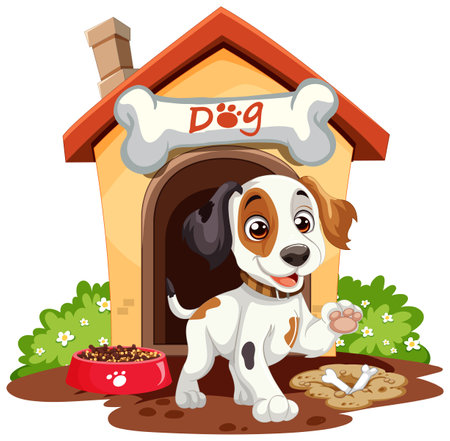1. Understanding Your Dog’s Nutritional Needs
When it comes to figuring out how often you should feed your dog, it’s important to start with the basics of canine nutrition. Not all dogs are the same—age, breed, and lifestyle all play a role in what and how often your furry friend should eat. Here’s a closer look at what makes each dog unique when it comes to mealtime.
Age Matters: Puppies vs. Adults vs. Seniors
Puppies burn through calories faster because they’re growing and always on the move, while adult dogs have more steady energy needs. Senior dogs might slow down but still need balanced nutrition. Here’s a quick guide:
| Life Stage | Typical Feeding Frequency | Special Considerations |
|---|---|---|
| Puppy (up to 12 months) | 3–4 times/day | Small meals support growth and energy |
| Adult (1–7 years) | 2 times/day | Consistent schedule helps digestion |
| Senior (7+ years) | 2 times/day | May need fewer calories but more fiber or joint support |
Breed Differences: Big Dogs vs. Small Dogs
The size of your dog affects not just portion size, but also how often they might want to eat. For example, toy breeds can have fast metabolisms and benefit from more frequent meals, while large breeds are prone to bloat and do better with fewer, well-timed meals.
| Breed Size | Meal Frequency Tips |
|---|---|
| Toy & Small Breeds | 3 small meals/day for steady energy |
| Medium & Large Breeds | 2 regular meals/day; avoid exercise right after eating to prevent bloat |
| Giant Breeds (Great Danes, Mastiffs) | 2–3 smaller meals/day; watch for signs of digestive discomfort |
Lifestyle Factors: Couch Potato or Adventure Buddy?
A dog’s daily routine matters, too. If your pup is mostly chilling at home, their calorie needs are lower than an active hiking partner or working dog. Adjust meal frequency and portions based on how much energy your dog burns throughout the day.
Common American Household Scenarios:
- The Suburban Family Dog: Usually gets moderate exercise; stick with 2 meals per day.
- The Urban Apartment Pup: May get less activity—watch portion sizes and avoid overfeeding.
- The Outdoor Adventurer: Needs extra calories and possibly an extra snack on busy days.
2. Recommended Meal Frequency by Life Stage
Just like people, dogs have different nutritional needs depending on their age and stage of life. In the U.S., most veterinarians and pet nutritionists recommend specific feeding schedules for puppies, adult dogs, and seniors to keep them healthy and happy. Let’s break down what’s ideal for each group.
Puppies (Under 1 Year Old)
Puppies are growing fast and burning a lot of energy! They need frequent meals to fuel their development and keep their blood sugar stable. For most breeds, here’s a typical feeding schedule:
| Puppy Age | Recommended Feedings per Day |
|---|---|
| 8-12 weeks | 4 times daily |
| 3-6 months | 3 times daily |
| 6-12 months | 2 times daily |
If you have a tiny or toy breed puppy, they may benefit from even more frequent, smaller meals to prevent low blood sugar.
Adult Dogs (1-7 Years Old)
Once your dog is fully grown, you can move to a more streamlined routine. Most American pet parents feed adult dogs twice a day—once in the morning and once in the evening. This schedule helps with digestion and keeps your pup satisfied throughout the day.
| Dog Size/Breed | Recommended Feedings per Day |
|---|---|
| Small to Large Breeds | 2 times daily |
| Toy Breeds* | 2-3 times daily (if needed) |
*Some toy breeds have faster metabolisms and may do better with three small meals.
Senior Dogs (7+ Years Old)
Seniors can sometimes experience changes in metabolism or appetite. However, the general rule in the U.S. is to continue with two meals a day unless your vet suggests otherwise based on health needs (like diabetes or digestive issues).
| Senior Dog Condition | Recommended Feedings per Day |
|---|---|
| No special medical needs | 2 times daily |
| With medical needs (consult vet) | May require 3+ small meals daily |
Always adjust meal frequency based on your dog’s energy level, weight goals, and any advice from your veterinarian. Consistency helps dogs know what to expect, making mealtime something they look forward to!
![]()
3. Factors That Influence Feeding Schedules
When deciding how often to feed your dog, it’s important to consider more than just their age or size. Many American families shape their dogs’ meal routines around daily habits, health needs, and activity levels. Let’s break down some of the most common factors that can influence your dog’s feeding schedule:
Activity Level
Dogs with high energy—like those who join you for morning jogs or play fetch in the backyard—often burn more calories and may need meals more frequently. Couch potatoes or older pups who spend much of the day lounging may do better with fewer feedings.
| Activity Level | Suggested Meals per Day |
|---|---|
| High (Active, working, athletic dogs) | 2-3 |
| Moderate (Daily walks, occasional play) | 2 |
| Low (Mostly indoors, less active) | 1-2 |
Health Conditions
If your dog has special health needs—such as diabetes, digestive issues, or is recovering from surgery—their vet might recommend a specific feeding routine. For example, diabetic dogs often do best with regular meal times matched to their insulin schedule. Always follow your veterinarians advice if your pup has unique medical needs.
Family Routines and Schedules
In many American homes, the dogs mealtime fits right into the family’s daily rhythm. If everyone leaves for work or school early, breakfast might be quick and easy. Dinner time could become a shared moment when everyone is home together. Consistency helps dogs know what to expect each day.
Typical Family Feeding Patterns in America
| Family Routine | Feeding Times Example |
|---|---|
| Traditional 9-to-5 Workday | 7:00 AM & 6:00 PM |
| Work-from-Home Families | Flexible: 8:00 AM & 5:00 PM or split into smaller meals throughout the day |
| Busy Evenings/Sports Activities | Early breakfast & late dinner: 6:30 AM & 7:30 PM |
Your Dog’s Preferences Matter Too!
No two dogs are exactly alike. Some will remind you when it’s time to eat by sitting by their bowl; others may graze slowly throughout the day if given the chance. Paying attention to your pup’s natural habits can help you fine-tune their ideal schedule.
4. Wet Food, Dry Food, and Mixed Meals
When it comes to how often you should feed your dog, the type of food you choose—wet food, dry kibble, or a mix of both—can make a big difference. American dog owners have a range of preferences, and each option has its own impact on your dog’s feeding schedule. Here’s what you need to know to match your meal plan with your dog’s diet.
Wet Food
Wet food is often seen as tastier and more aromatic for dogs, making it a popular choice for picky eaters or older pups who might struggle with chewing. Because wet food is higher in moisture and sometimes lower in calories per serving compared to dry kibble, dogs may need slightly larger portions or more frequent meals to meet their daily nutritional needs. Many U.S. owners who feed only wet food opt for two meals per day, but some split it into three smaller meals to keep energy levels steady and avoid hunger between feedings.
Dry Food (Kibble)
Kibble is convenient, budget-friendly, and easy to store. It’s also great for dental health since the crunchy texture can help clean your dog’s teeth. Dry food tends to be more calorie-dense than wet food, so portion sizes are usually smaller. Most American households using dry food stick to the classic twice-a-day feeding routine for adult dogs, while puppies might need three meals daily because of their fast growth and energy needs.
Mixed Meals
Mixing wet and dry foods has become increasingly trendy among U.S. pet parents. This approach gives dogs the best of both worlds: the flavor and moisture of wet food plus the crunchiness and convenience of kibble. If you’re mixing foods, pay attention to the overall calorie count to avoid overfeeding. Most people who use a mixed approach continue with two meals per day for adults but adjust portions based on their dog’s activity level and appetite.
Quick Look: Feeding Frequency by Food Type
| Food Type | Puppies (under 1 year) | Adult Dogs (1-7 years) | Seniors (7+ years) |
|---|---|---|---|
| Wet Food | 3-4 times/day | 2-3 times/day | 2 times/day |
| Dry Food (Kibble) | 3 times/day | 2 times/day | 1-2 times/day |
| Mixed Meals | 3 times/day | 2 times/day | 2 times/day |
Trends Among U.S. Dog Owners
A lot of American families are moving toward flexible meal plans that fit busy lifestyles—think automatic feeders for kibble or prepping wet food ahead of time. There’s also growing interest in rotating between different types of food throughout the week to keep dogs interested at mealtime. Whatever you choose, remember that consistency is key for your pup’s digestion and happiness.
5. Signs You Might Need to Adjust Your Dogs Feeding Routine
Even if you’ve chosen a feeding schedule that fits your dog’s age and breed, dogs are individuals with their own habits and needs. It’s important to stay observant and notice the little ways your pup might be telling you it’s time for a change. Here are some key behavioral and health cues to watch for:
Common Behavioral Signs
| Sign | What It Might Mean |
|---|---|
| Begging Between Meals | Your dog could be hungry, not getting enough calories, or their meal schedule doesn’t match their activity level. |
| Lack of Interest in Food | Portion size may be too large, meals are too frequent, or your dog is bored with the food. |
| Guarding Food or Rushing to Eat | This can indicate hunger or anxiety about mealtime; sometimes smaller, more frequent meals help. |
| Restlessness Near Mealtime | Your dog may need more predictable meal timing or an adjustment in portion size. |
Physical and Health Cues
| Cue | Possible Cause | Suggested Action |
|---|---|---|
| Noticeable Weight Gain or Loss | Overfeeding or underfeeding; wrong meal frequency for breed/age/activity level. | Check serving sizes and talk to your vet about ideal weight goals. |
| Dips in Energy (Lethargy) | Not enough food or meals spaced too far apart. | Try splitting daily food into more servings or adjusting feeding times. |
| Frequent Upset Stomach (Vomiting/Diarrhea) | Too much food at once, irregular feeding times, or unsuitable diet. | Switch to smaller portions more often and consult your vet if symptoms persist. |
| Poor Coat Condition | Nutritional deficiency from improper feeding routine. | Review food quality and ensure balanced nutrition in each meal. |
When to Make Changes?
If you notice one or more of these signs, it might be time to tweak your dog’s feeding routine. Sometimes small changes—like shifting mealtimes by an hour or dividing food into two instead of one big meal—can make a big difference. As always, when in doubt, check with your veterinarian before making major adjustments to your dog’s diet.
6. Tips to Make Feeding Time Easier
Find a Routine That Fits Your Life
Busy American lifestyles mean that feeding your dog on time can be tricky, but with the right plan, it’s totally doable! The key is to create a routine that works for you and your family while making sure your pup stays healthy and happy.
Set Up a Consistent Schedule
Dogs love routines. Try to feed your dog at the same times every day. Consistency helps regulate digestion and makes dogs feel secure. Here’s a sample schedule for different meal frequencies:
| Meal Frequency | Ideal Times | Best For |
|---|---|---|
| Once Daily | Evening (after work/school) | Adult dogs, low-energy households |
| Twice Daily | Morning (before leaving) Evening (dinnertime) |
Most adult dogs and busy families |
| Three Times Daily | Early morning Noon Evening |
Puppies, seniors, or special needs dogs |
Use Tech to Make It Simple
Automatic Feeders
If your schedule is unpredictable, try an automatic feeder. These devices let you pre-set meal times and portion sizes, so your dog eats on time even when you’re stuck in traffic or working late.
- Smart feeders: Control feeding from your phone—perfect for tech-savvy families.
- Treat-dispensing cameras: Check in and give treats or meals remotely for extra fun!
Reminders & Apps
Set alarms on your phone or use pet care apps to remind you and your family when it’s mealtime. Some apps even track how much your dog has eaten each day.
Get the Whole Family Involved
Sharing responsibility keeps everyone engaged and ensures your dog never misses a meal. Assign tasks based on age and availability:
| Family Member | Feeding Task Ideas |
|---|---|
| Kids (6+) | Scoop food, refill water bowl with supervision, mark off the feeding chart. |
| Teens/Adults | Measure portions, set up automatic feeders, monitor special dietary needs. |
| Seniors/Grandparents | Add supplements/treats, check if food/water bowls are clean. |
Create a Feeding Chart or Calendar
A simple whiteboard calendar or a digital shared calendar helps everyone know whose turn it is to feed the dog. It also helps spot any missed meals quickly.
A Few More Handy Tips:
- Keeps bowls in the same place: Dogs thrive with predictable environments.
- Avoid table scraps: Stick to the feeding schedule for better health.
- Cater to weekends: If routines change, try to keep mealtimes within an hour of weekdays.
- Add playtime before or after meals: Builds positive associations with eating routines!


